Compact Dual Circularly-Polarized Quad-Element MIMO/Diversity Antenna for Sub-6 GHz Communication Systems
Abstract
:1. Introduction
2. Antenna Configuration
2.1. Development Process
2.2. Mutual-Coupling Reduction
2.3. Circular Polarization Mechanism
3. Results and Discussion
4. Performance Comparison
5. Conclusions
Author Contributions
Funding
Institutional Review Board Statement
Informed Consent Statement
Data Availability Statement
Conflicts of Interest
References
- Papamichael, V.C.; Karadimas, P. Performance evaluation of actual multielement antenna systems under transmit antenna selection/maximal ratio combining. IEEE Antennas Wireless Propag. Lett. 2011, 10, 690–692. [Google Scholar] [CrossRef]
- Singh, G.; Kumar, S.; Kanaujia, B.K.; Pandey, V.K. Design and implementation of a compact tri-band four-port multiple-input-multiple-output antenna. Int. J. RF Microw. Comput. Aided Eng. 2022, 32, e23218. [Google Scholar] [CrossRef]
- Birwal, S.; Singh, B.; Kanaujia, K.; Kumar, S. MIMO/diversity antenna with neutralization line for WLAN applications. MAPAN 2021, 36, 763–772. [Google Scholar] [CrossRef]
- Alibakhshikenari, M.; Babaeian, F.; Virdee, B.S.; Aissa, S.; Azpilicueta, L.; See, C.H.; Althuwayb, A.A.; Huynen, I.; Abd-Alhameed, R.A.; Falcone, F.; et al. A comprehensive survey on “various decoupling mechanisms with focus on metamaterial and metasurface principles applicable to SAR and MIMO antenna systems. IEEE Access 2020, 8, 192965–193004. [Google Scholar] [CrossRef]
- Govindan, T.; Palaniswamy, S.K.; Kanagasabai, M.; Velan, S.; Kumar, S.; Rao, T.R. Quad-port electromagnetic band gap (EBG)–backed non-isomorphic multiple-input-multiple-output (MIMO) antenna for wearable applications. Flex. Print. Electron. 2022, 7, 035020. [Google Scholar] [CrossRef]
- Singh, G.; Kanaujia, B.K.; Pandey, V.K.; Kumar, S. Quad-band multi-polarized antenna with modified electric-inductive-capacitive resonator. Int. J. Microw. Wireless Technol. 2022, 14, 65–76. [Google Scholar] [CrossRef]
- Srivastava, K.; Kumar, S.; Kanaujia, B.K.; Dwari, S.; Choi, H.C.; Kim, K.W. Compact eight-port MIMO/diversity antenna with band rejection characteristics. Int. J. RF Microw. Comput. Aided Eng. 2020, 30, e22170. [Google Scholar] [CrossRef]
- Alsath, M.G.N.; Arun, H.; Selvam, Y.P.; Kanagasabai, M.; Kingsly, S.; Subbaraj, S.; Sivasamy, R.; Palaniswamy, S.K.; Natarajan, R. An integrated tri-band/UWB polarization diversity antenna for vehicular networks. IEEE Trans. Veh. Technol. 2018, 67, 5613–5620. [Google Scholar] [CrossRef]
- Bilal, M.; Saleem, R.; Abbasi, H.H.; Shafique, M.F.; Brown, A.K. An FSS-based nonplanar quad-element UWB-MIMO antenna system. IEEE Antennas Wireless Propag. Lett. 2017, 16, 987–990. [Google Scholar] [CrossRef]
- Kaim, V.; Kanaujia, B.K.; Kumar, S.; Choi, H.C.; Kim, K.W.; Rambabu, K. Electrically small circularly polarized UWB intraocular antenna system for retinal prosthesis. IEEE Trans. Biomed. Eng. 2022, 69, 3504–3515. [Google Scholar] [CrossRef]
- Kumar, S.; Lee, G.H.; Kim, D.H.; Mohyuddin, W.; Choi, H.C.; Kim, K.W. A compact four-port UWB MIMO antenna with connected ground and wide axial ratio bandwidth. Int. J. Microw. Wireless Technol. 2020, 12, 75–85. [Google Scholar] [CrossRef]
- Nadeem, I.; Alibakhshikenari, M.; Babaeian, F.; Althuwayb, A.A.; Virdee, B.S.; Azpilicueta, L.; Khan, S.; Huynen, I.; Falcone, F.; Denidni, T.A.; et al. A comprehensive survey on ‘circular polarized antennas’ for existing and emerging wireless communication technologies. J. Phys. D Appl. Phys. 2022, 55, 033002. [Google Scholar] [CrossRef]
- Birwal, S.; Singh, B.; Kanaujia, K.; Kumar, S. Broadband CPW-fed circularly polarized antenna for IoT-based navigation system. Int. J. Microw. Wireless Technol. 2019, 11, 835–843. [Google Scholar] [CrossRef]
- Malik, J.; Patnaik, A.; Kartikeyan, M.V. Novel printed MIMO antenna with pattern and polarization diversity. IEEE Antennas Wireless Propag. Lett. 2015, 14, 739–742. [Google Scholar] [CrossRef]
- Sharma, Y.; Sarkar, D.; Saurav, K.; Srivastava, K.V. Three-element MIMO antenna system with pattern and polarization diversity for WLAN applications. IEEE Antennas Wireless Propag. Lett. 2017, 16, 1163–1166. [Google Scholar] [CrossRef]
- Saini, R.K.; Dwari, S. A broadband dual circularly-polarized square slot antenna. IEEE Trans. Antennas Propag. 2016, 64, 290–294. [Google Scholar] [CrossRef]
- Chandu, D.S.; Karthikeyan, S.S. A novel broadband dual circularly-polarized microstrip-fed monopole antenna. IEEE Trans. Antennas Propag. 2017, 65, 1410–1415. [Google Scholar]
- Jamal, M.Y.; Li, M.; Yeung, K.L. Isolation enhancement of closely packed dual circularly polarized MIMO antenna using hybrid technique. IEEE Access 2020, 8, 11241–11247. [Google Scholar] [CrossRef]
- Ullah, U.; Mabrouk, I.B.; Koziel, S. Enhanced-performance circularly polarized MIMO antenna with polarization/pattern diversity. IEEE Access 2020, 8, 11887–11895. [Google Scholar] [CrossRef]
- Kumar, S.; Lee, G.H.; Kim, D.H.; Choi, H.C.; Kim, K.W. Dual circularly polarized planar four-port MIMO antenna with wide axial-ratio bandwidth. Sensors 2020, 20, 5610. [Google Scholar] [CrossRef]
- Saxena, S.; Kanaujia, B.K.; Dwari, S.; Kumar, S.; Choi, H.C.; Kim, K.W. Planar four-port dual circularly-polarized MIMO antenna for sub-6 GHz band. IEEE Access 2020, 8, 90779–90791. [Google Scholar] [CrossRef]
- Sharawi, M.S. Current misuses and future prospects for printed multiple-input, multiple-output antenna systems. IEEE Antennas Propag. Mag. 2017, 59, 162–170. [Google Scholar] [CrossRef]
- Available online: https://www.qualcomm.com/media/documents/files/5g-spectrum-update-for-mipi-alliance.pdf (accessed on 1 June 2022).
- Jamshed, M.A.; Ur-Rehman, M.; Frnda, J.; Althuwayb, A.A.; Nauman, A.; Cengiz, K. Dual band and dual diversity four-element MIMO dipole for 5G handsets. Sensors 2021, 21, 767. [Google Scholar] [CrossRef] [PubMed]
- Althuwayb, A. Low-interacted multiple antenna systems based on metasurface-inspired isolation approach for MIMO applications. Arab. J. Sci. Eng. 2022, 47, 2629–2638. [Google Scholar] [CrossRef]
- Ikram, M.; Nguyen-Trong, N.; Abbosh, A. Multiband MIMO microwave and millimeter antenna system employing dual-function tapered slot structure. IEEE Trans. Antennas Propag. 2019, 67, 5705–5710. [Google Scholar] [CrossRef]
- Sharma, S.; Mainuddin; Kanaujia, B.K.; Khandelwal, M.K.; Kumar, S. Design of 4-element microstrip array of wideband reflector antenna with stable high gain characteristics. Microsyst. Technol. 2019, 25, 3193–3201. [Google Scholar] [CrossRef]
- Kumar, S.; Nandan, D.; Srivastava, K.; Kumar, S.; Singh, H.; Marey, M.; Kanaujia, B.K. Wideband circularly polarized textile MIMO antenna for wearable applications. IEEE Access 2021, 9, 108601–108613. [Google Scholar] [CrossRef]
- Ghadimi, A.; Nayyeri, V.; Khanjarian, M.; Soleimani, M.; Ramahi, O.M. A systematic approach for mutual coupling reduction between microstrip antennas using pixelization and binary optimization. IEEE Antennas Wireless Propag. Lett. 2020, 19, 2048–2052. [Google Scholar] [CrossRef]
- Blanch, S.; Romeu, J.; Corbella, I. Exact representation of antenna system diversity performance from input parameter description. Electron. Lett. 2003, 39, 705–707. [Google Scholar] [CrossRef] [Green Version]



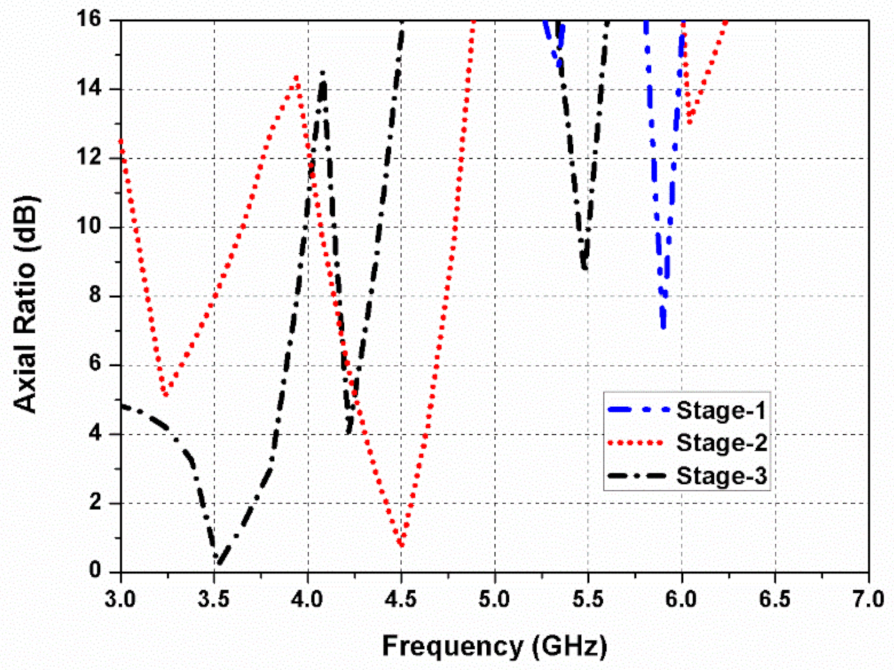
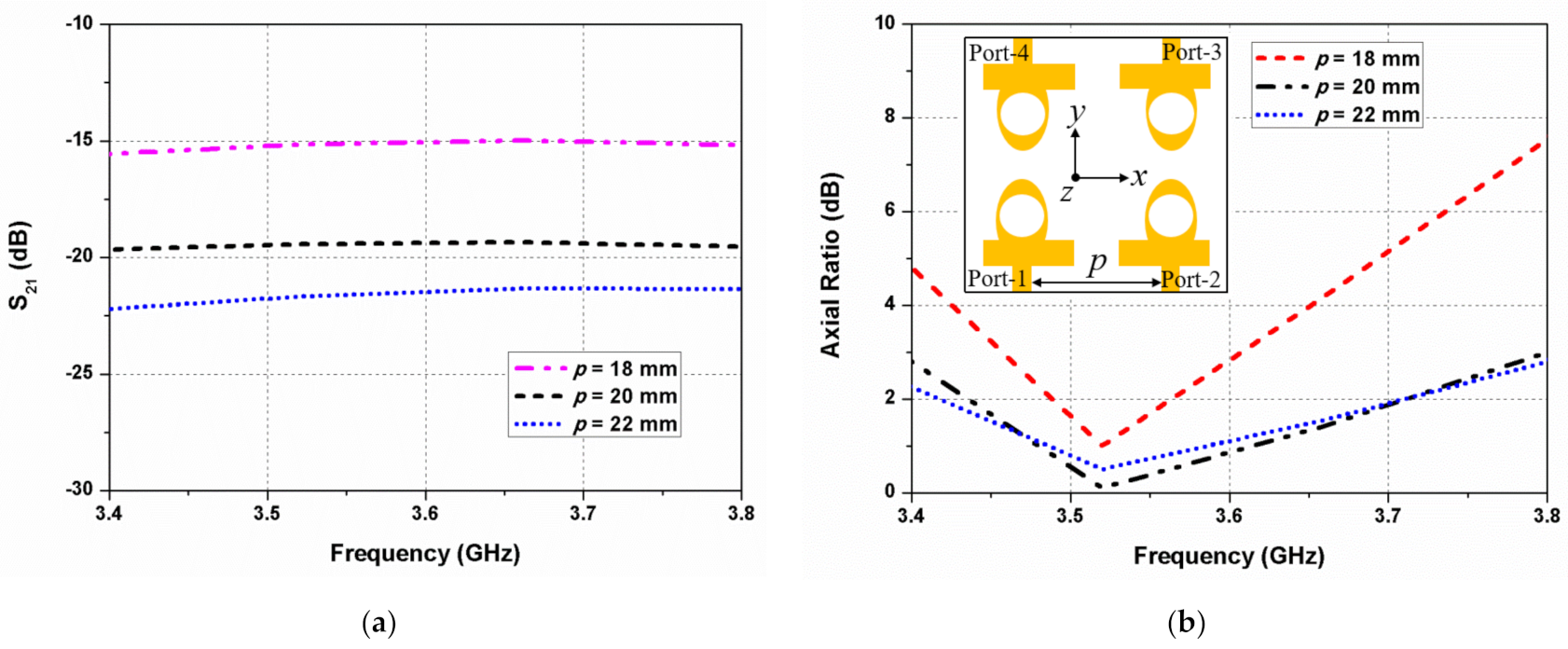


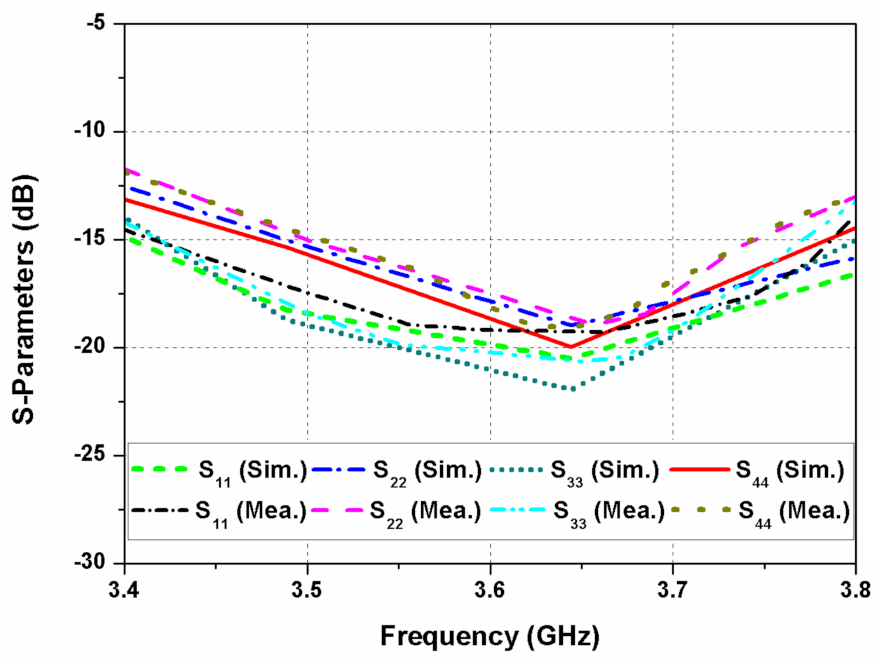
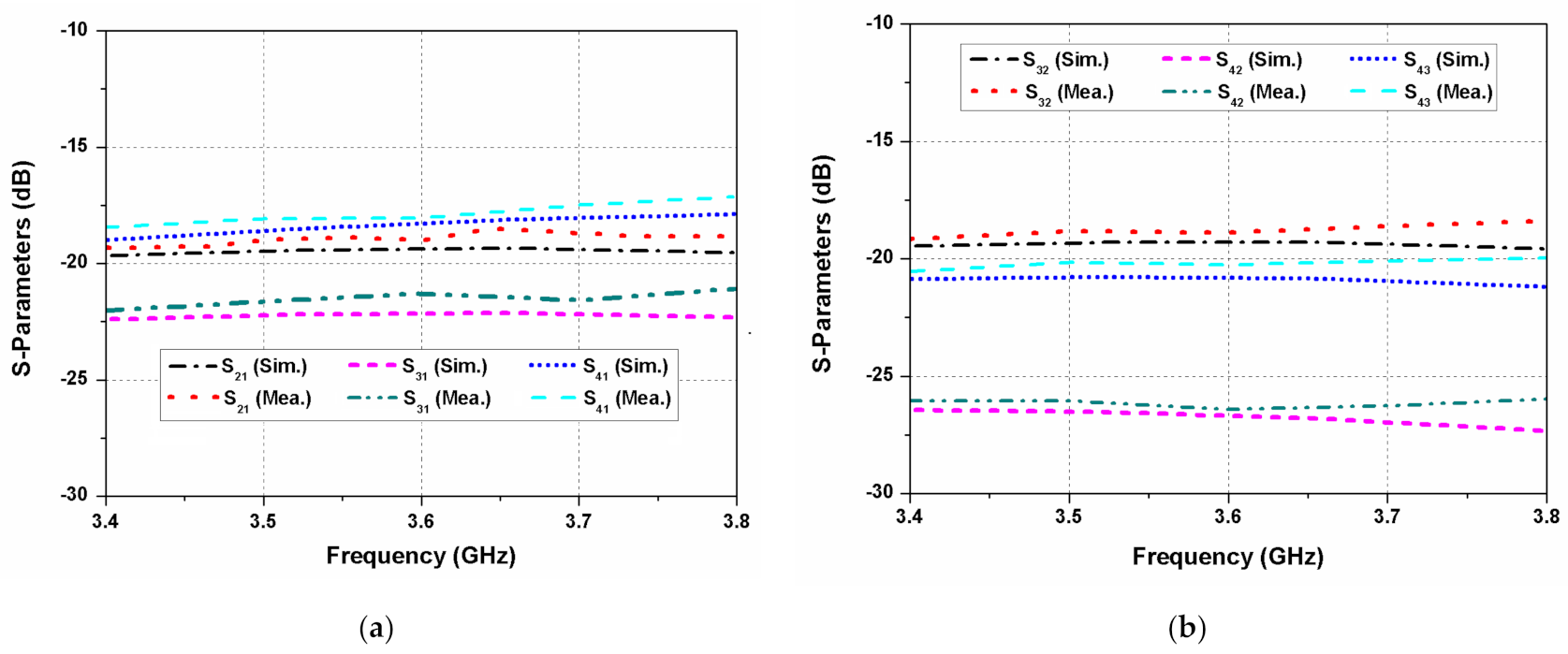

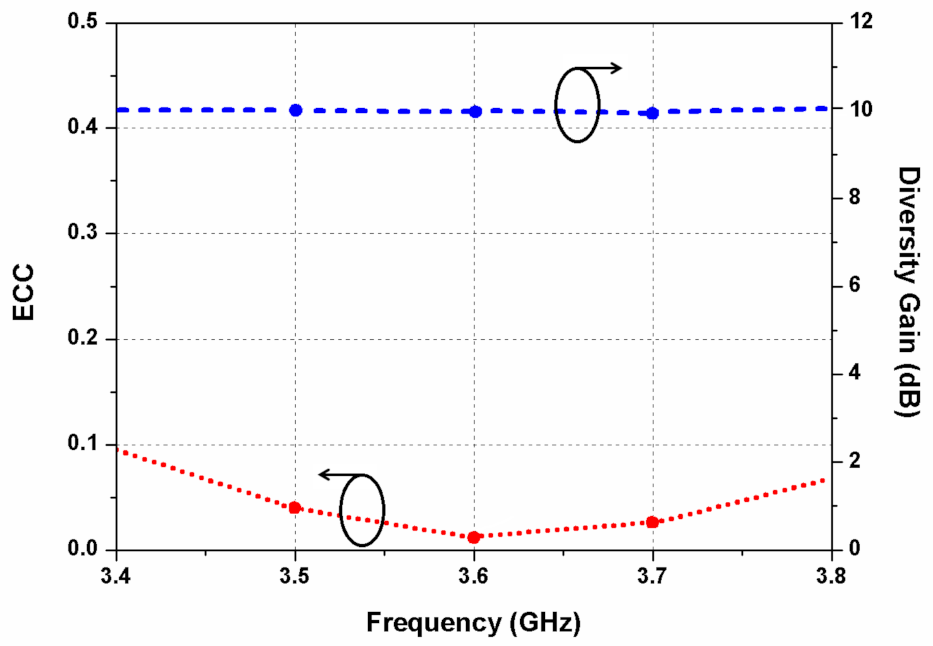
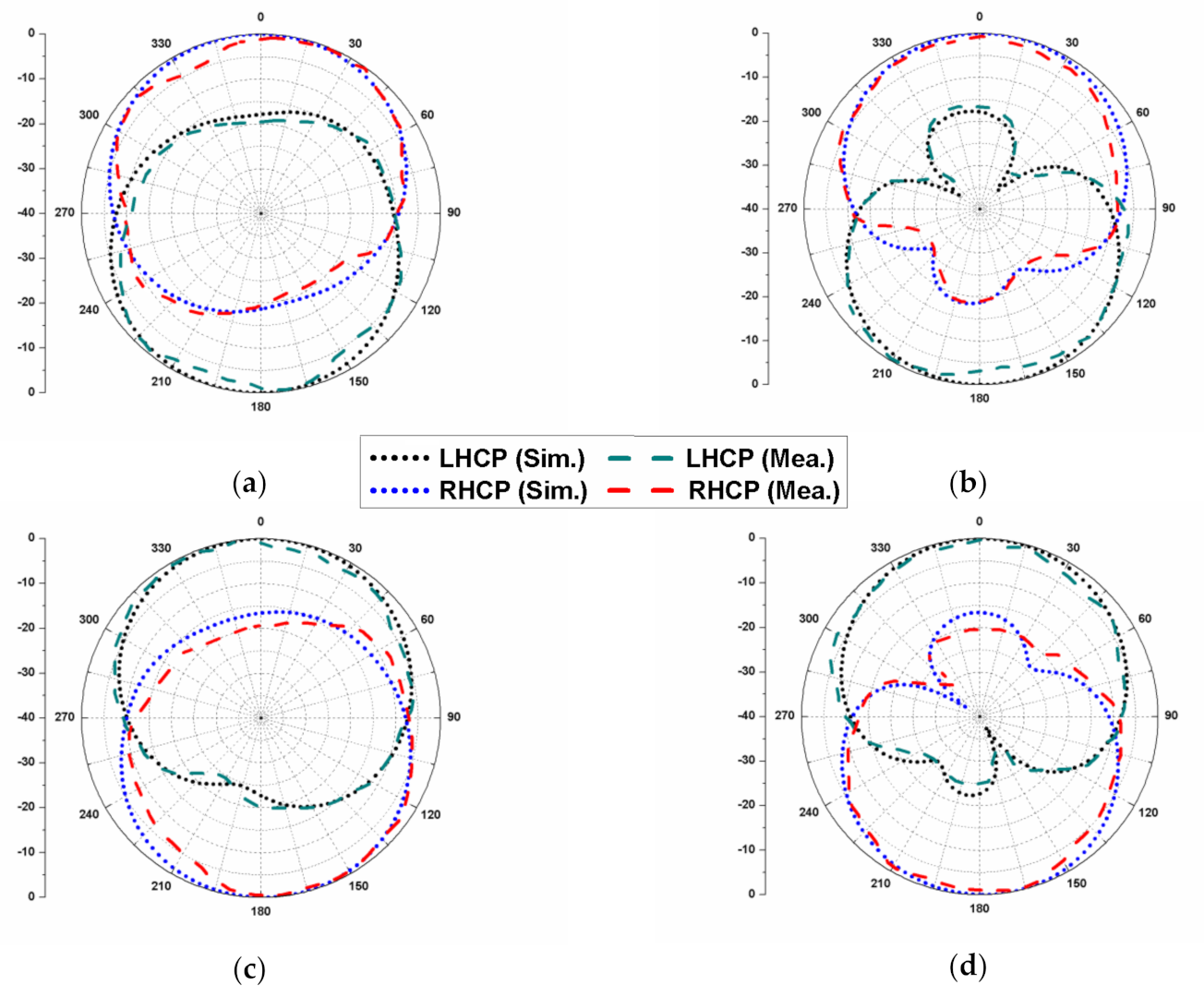
| Dimensions | Value (mm) | Dimensions | Value (mm) |
|---|---|---|---|
| L | 40 | a | 7 |
| t | 1.6 | b | 4 |
| h | 4 | r | 3.5 |
| w | 3 | p | 20 |
| u | 14 | q | 24 |
| v | 4 |
| Ref. | Design Methodology | No. of Resonators | Polarization | (S11 ≤ −10 dB) Band (GHz) | 3-dB Axial Ratio Band (GHz) | Antenna Size (mm3) | Connected Grounds | Isolation (dB) | Edge-to-Edge Distance b/w the Radiators (mm) | ECC | Peak Gain (dB) | Design Complexity |
|---|---|---|---|---|---|---|---|---|---|---|---|---|
| [14] | Front-to-back radiators | 2 | LP/ RHCP | 5.4–6.1 | 5.8, 5.9, 6 | 25 × 30 × 1.524 | No | >13 | 1.524 | <0.06 | 4.3 | High |
| [15] | Non-identical resonators | 3 | LP/ RHCP | 5.4–6.2 | 5.61–5.7 | 29 × 48 × 1.6 | Yes | >15 | 8.35 | <0.01 | 4 | High |
| [16] | Wide slot | 2 | LHCP/ RHCP | 2–4.76 | 2–3.7 | 60 × 60 × 1.6 | Yes | >15 | 15.2 | --- | 4 | Moderate |
| [17] | Shared radiator | 2 | LHCP/ RHCP | 1.4–8.73 | 3.74–8.8 | 32 × 32 × 1 | No | >20 | 32 | <0.5 | 3.8 | High |
| [18] | Stubs and defected ground | 2 | LHCP/ RHCP | 2.47–2.55 | 2.5–2.66 | 100 × 150 × 0.8 | Yes | >20 | ~61 | <0.003 | 6.1 | Moderate |
| [19] | Mirrored-image | 2 | LHCP/ RHCP | 5.2–6.3 | 5.2–6.3 | 13.7 × 36.2 × 0.813 | No | >22 | 23 | <0.002 | 5.8 | Moderate |
| [20] | Mirrored-image | 4 | LHCP/ RHCP | 4–13 | 4.2–8.5 | 70 × 68 × 1.6 | Yes | >18 | 36 | <0.25 | 6.4 | Moderate |
| [21] | Mirrored-image | 4 | LHCP/ RHCP | 3.4–3.8 | 3.46–3.7 | 60 × 60 × 1.6 | Yes | >19 | 43 | <0.12 | 4.5 | High |
| Prop. | Mirrored-image | 4 | LHCP/ RHCP | 3.4–3.8 | 3.4–3.8 | 40 × 40 × 1.6 | Yes | >18 | 20 | <0.1 | 5 | Low |
Publisher’s Note: MDPI stays neutral with regard to jurisdictional claims in published maps and institutional affiliations. |
© 2022 by the authors. Licensee MDPI, Basel, Switzerland. This article is an open access article distributed under the terms and conditions of the Creative Commons Attribution (CC BY) license (https://creativecommons.org/licenses/by/4.0/).
Share and Cite
Kumar, S.; Palaniswamy, S.K.; Choi, H.C.; Kim, K.W. Compact Dual Circularly-Polarized Quad-Element MIMO/Diversity Antenna for Sub-6 GHz Communication Systems. Sensors 2022, 22, 9827. https://doi.org/10.3390/s22249827
Kumar S, Palaniswamy SK, Choi HC, Kim KW. Compact Dual Circularly-Polarized Quad-Element MIMO/Diversity Antenna for Sub-6 GHz Communication Systems. Sensors. 2022; 22(24):9827. https://doi.org/10.3390/s22249827
Chicago/Turabian StyleKumar, Sachin, Sandeep Kumar Palaniswamy, Hyun Chul Choi, and Kang Wook Kim. 2022. "Compact Dual Circularly-Polarized Quad-Element MIMO/Diversity Antenna for Sub-6 GHz Communication Systems" Sensors 22, no. 24: 9827. https://doi.org/10.3390/s22249827








